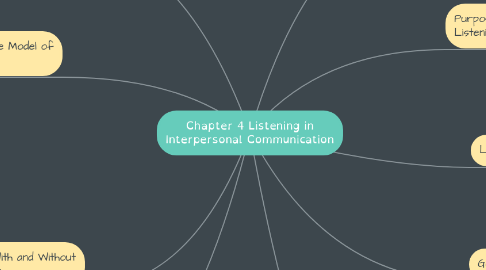
1. Stages of Listening Process
1.1. Receiving
1.1.1. Focus Attention on Speaker’s Verbal and Nonverbal Cues
1.1.2. Avoid distractions
1.1.3. Maintain your role as listener
1.1.4. Avoid Interrupting
1.1.5. Hedging
1.1.6. Credentialling
1.1.7. Sin Licenses
1.1.8. Cognitive disclaimers
1.1.9. Appeals for the suspension of judgement
1.1.10. Avoid distractions
1.2. Understanding
1.2.1. Avoid Assuming You Understand
1.2.2. See Speaker’s Point of View
1.2.3. Ask Questions for Clarification
1.2.4. Paraphrase Speaker’s Ideas
1.3. Remembering
1.3.1. Identify Central Ideas and Major Support
1.3.2. Summarize the Message
1.3.3. Repeat Names and Key Concepts
1.3.4. Take notes in outline form
1.3.5. Assume relevance
1.3.6. Prepare yourself to listen
1.3.7. Avoid distractions
1.3.8. Pay special attention to the introduction
1.3.9. Listen for understanding
1.4. Evaluating
1.4.1. Resist evalution
1.4.2. Distinguish facts from opinions
1.4.3. Identify any biases
1.4.4. Recognize fallacious forms of "reasoning"
1.4.4.1. Name-calling
1.4.4.2. Testimonial
1.4.4.3. Bandwagon
1.5. Responding
1.5.1. Support the speaker
1.5.2. Own your responses
1.5.3. Resist "responding to another's feelings with "solving the person's problems"
1.5.4. Focus on the other person
1.5.5. Avoid being a thought-completing listener
2. Implications of the Model of Listening
2.1. Listening is a Collection of Skills
2.2. All Five Stages Overlap
2.3. Listening is Never Perfect
2.4. Listening is Situational
3. Between People With and Without Hearing Difficulties
3.1. unimpaired role
3.1.1. Avoid interference
3.1.2. Speak at an adequate volume
3.1.3. Phrase ideas in different ways
3.1.4. Avoid overlapping speech
3.1.5. Use nonverbal cues
3.2. Impaired Role
3.2.1. Do your best to eliminate background noise
3.2.2. Move closer to the speaker if this helps your hear better
3.2.3. Ask for adjusments
3.2.4. Position yourself for the best reception
3.2.5. Ask for additional cues
4. Culture and Listening
4.1. Language and Speech
4.2. Nonverbal Behaviors
4.3. Feedback
5. The Important of Listening
5.1. Establish and Communicate Power
5.2. Job advancement
5.3. More Likely to Emerge as a Leader
5.4. Relationship Development
6. Purposes and Payoffs of Listening
6.1. Learning
6.2. Relating
6.3. Influencing
6.4. Playing
6.5. Helping
7. Listening Barriers
7.1. Physical/Mental Distractions
7.2. Biases and Prejudices
7.3. Lack of focus
7.4. Premature Judgment
8. Gender and Listening
8.1. Rapport and Report Talk
8.2. Listening Cues
8.3. Amount and Purpose of Listening
8.4. Differences Changing Rapidly
9. Styles of Listening
9.1. Emphatic and Objective
9.1.1. Punctuate the message from the speaker's point of view
9.1.2. Engage in equal, two-way conversation
9.1.3. Seek to understand both thoughts and feelings
9.1.4. Avoid "offensive listening"
9.1.5. Strive to be objective
9.2. Nonjudgmental and Critical
9.2.1. Keep an open mind and avoid prejudging
9.2.2. Avoid Filtering out or oversimplifying complex messages
9.2.3. Recognize your own biases
9.2.4. Avoid sharpening
9.2.5. Recognize the fallacies of language
9.3. Surface and Depth Listening
9.3.1. Weasel words
9.3.2. Euphemisms
9.3.3. Jargon
9.3.4. Gobbledygook
9.4. Active and Inactive
9.4.1. Paraphrase Speaker’s Meaning
9.4.2. Express Understanding of Speaker’s Feelings
9.4.3. Ask Questions
